By Jeffrey A. Rendall, Photos by Jeffrey A. Rendall
Note: Information regarding the 2013 US Amateur Public Links will follow the story.
LORTON, VA – Traveling past a prison is always a sobering experience, considering not only what’s living behind the barriers, but also what it must have taken to put the inmates there in the first place.
Nobody wants to live by a jail, either. Penitentiaries and landfills rank highest on every community’s ‘not in my backyard’ list of agenda items to shout over at the next Planning Board meeting.
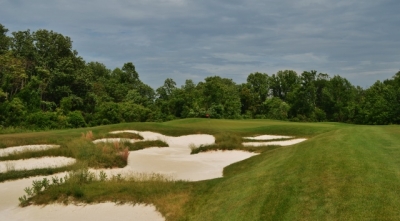 |
| Players going for the green in two on the par five 5th hole may end up in these bunkers unless they aim to the right of the green. |
So when there’s an opportunity to turn a formerly undesirable penal complex into something to be proud of, it’s a chance well worth taking. This was the case at Laurel Hill Golf Club, which rests on the grounds of the old Lorton Corrections facility in Northern Virginia.
From portions of the golf course, you can still see Lorton’s old buildings, fences and barbed wire, so the reminder’s still fresh (though less fresh than it used to be, there's a nice looking housing development and school there now) – but there’s little doubt that this Bill Love designed layout is a heck of a way to turn an ugly disgrace into something beautiful and useful once again.
“The adaptive re-use aspect of the project was something that got us excited about it from the beginning,” Love said. “Here you take something that was, let’s face it, an eyesore – but also a thing that everybody had to drive by and just say ‘oooohhhh.’ What they’ve (Fairfax County Park Authority) done with the site is nothing short of remarkable.”
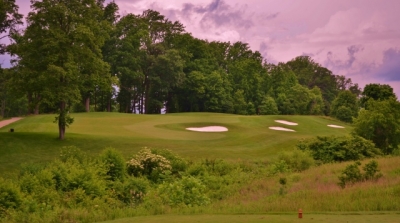 |
| At 218 yards and playing slightly uphill, the par three 14th hole is probably Laurel Hill's toughest one-shotter. |
Indeed. Harkening back to the mid 90's when they announced the impending shutdown of the Lorton Prison, more than a few thoughts ran through our heads as to what they were going to do with it when the cells were locked for a final time.
It turns out that many saw the closed prison as much of a business opportunity as a cultural improvement story -- and new housing developments began sprouting up around the prison, with attractive views to match. Then came word that there was a golf course being built on the grounds, and it began to sound very attractive.
Gene Orrico, Laurel Hill’s Head Golf Professional, sheds light on the project’s evolution: “After the prison was closed, a large home builder approached the County about buying some of the prison property – and from that there was an agreement between the County, the schools (which were also getting some of the real estate) and the home builder to develop the land, which included a new senior living community (‘Spring Hill’).”
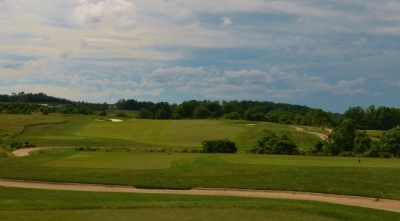 |
| Looking from the tee of the par four 6th hole. There is 500 yards of Fairfax real estate in front of you. |
Then shortly after the agreement was struck, the County decided to build a golf course as part of the reclamation of the property. Someone needed to design it -- from which a search was conducted, ending with the hiring of Love to sketch out the facility. Orrico said Love was chosen because of his reputation for environmental sensitivity – and the Laurel Hill project had a number of potential issues involved in this realm.
Love said he was amazed at the property’s potential: “Being a long-time area resident, I was aware of Lorton, just like everybody else. But when I got out there and realized how much property was attached to the facility (about 3000 acres), it’s like ‘Holy Mackerel.’ All that land right in the middle of Fairfax County. Then we walked the ground available for the golf course, and I couldn’t get over how beautiful it was. Who would have ever thought this was all part of Lorton Prison?”
He continues, “We then began laying out the golf course and started getting into some problems with the initial parcels we were working with – because the land had so many environmentally sensitive streams that ran through it. We ended up flying over the creek seven or eight times, and we knew that wouldn’t work from an environmental or public play standpoint. That’s way too many demand carries.”
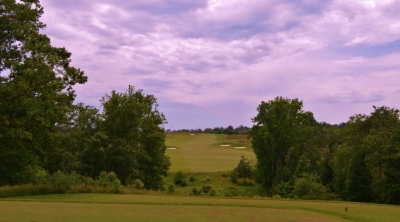 |
| Even with clouds you can still see the obvious beauty of Laurel Hill from the tee of the par four 3rd hole. |
Love then met with the Park Authority and suggested some alternatives, which basically included annexing a portion of the property that now holds the fourth, fifth and sixth holes. He said what they’d give up in land value would be saved in grading expenses and also greatly reduced the number of stream crossings – environmental and public play cost benefits that made sense. So they went ahead with it.
Because of the rolling nature of the property and the fact that it occupies so many acres, there’s quite an expansive feel at Laurel Hill. Very few holes directly border others, and from many spots on the course, you probably won’t even be able to see other golfers.
True, you’re in the middle of a busy suburban neighborhood, yet it feels like you’re out in the country. It doesn’t get much better for the golf nut looking to ‘escape’ from his own private urban ‘prison.’
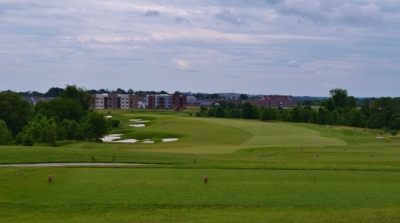 |
| Signs of renewal are everywhere at Laurel Hill, including the view of the par four 10th hole. |
Okay, bad analogy… but couldn’t pass it up.
Enhancing that overall mood is the three silos on property, which came along with the history of the Lorton Prison. Contrary to our preconceived notions of what prisoners do, or did – for many years they operated a working dairy farm on site, and that land is now part of the Laurel Hill Golf Club.
The silos add to the ‘pastoral feel’ of Laurel Hill, but according to Love, they also serve as homes for some other ‘residents,’ who actually choose to live there now. “One time during a field investigation, before we laid out the golf holes, a county official brought us over to one of the silos and said ‘look up.’ We looked up and there, staring down at us were three sets of beady owl eyes. Barn owls apparently migrate from silo to silo, and the county people wanted us to preserve the silos if it didn’t interfere with the routing. I said it was no problem, and now those silos definitely contribute to the expansive rural feel of the golf course.”
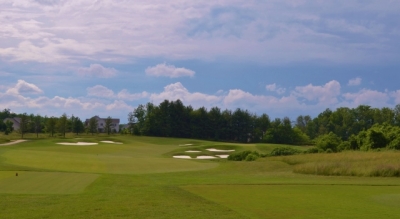 |
| The short par four 7th just dares you to go for it off the tee, but all those bunkers are anxiously waiting for an errant drive. Good luck! |
The owls do, too. Especially around Halloween time.
The barns and silos weren’t the only historic relics that Love had to deal with. There used to be a huge shooting range (and teargas practice area) on site, with large earthen walls built up around it – which is now the par five 15th hole and the driving range. All of it had to be graded and taken out, and restored to a naturalized state.
“It was very interesting seeing all of those structures disassembled and some of the ramifications from it. As part of the environmental aspect of taking out the practice target range, they had to extract all the lead out of the ground – I believe I heard they took out three tons of it from the earthen embankments,” Love said.
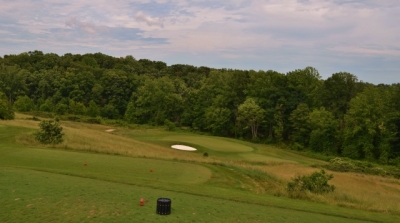 |
| The par three 4th hole offers a look at the abundant native grasses found at Laurel Hill. |
That’s a lot of bullets. Now you get to fire golf shots on the old target range. Talk about useful land reclamation.
One final bit of history – the Laurel Hill property once was a Nike missile control site, during the Cold War days. The land adjacent to the 7th fairway was originally intended to host the Cold War Museum, but those plans fell through (and the museum is now located in Fauquier County).
Fortunately for golfers, Laurel Hill is much more than just an interesting story -- the golf course calls for some precise shot-making. Gone are the days when you’re expecting a ‘muni’ to be flat, boring, and relatively easy. If Laurel Hill is the antithesis to the ‘muni’ stereotype in the aesthetic sense, it’ll differ from the norm in difficulty as well.
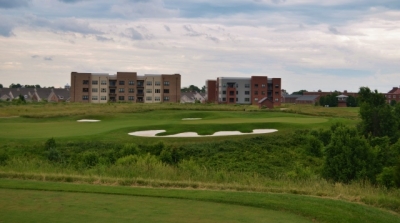 |
| Right near the old prison grounds, the par three 11th hole shows off the new residents of the area. |
Orrico points out that it plays over 7,000 yards from the back tees (and just over 7100 from the Championship tees), which isn’t a huge number in the 21st century, but it also has five par threes (par 71). Simply put, Laurel Hill’s got some of the meatiest par fours in northern Virginia, which will test the region’s best players.
Love said they wanted it that way: “The Park Authority said one of the design objectives was to make Laurel Hill what they called the ‘flagship’ of their golf system. So we looked at it from that standpoint, and started talking about maybe making it a little bigger, or giving it more room around the holes, in order to create this high-quality golf experience. And part of that was making it challenging enough to take on the best players.”
True, there are some short holes like the 321-yard, par four seventh. But just one link prior is the 500-yard monster par four sixth. You’ll see some fours on the PGA Tour with a ‘5’ leading the yardage figure, but it’s a rarity in ‘our’ world. It doesn’t matter that the hole plays downhill, it’s still an endurance test.
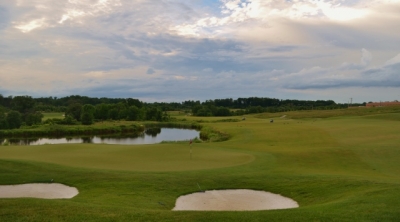 |
| From behind the green on the par five 18th hole. Not exactly the look of a 'muni,' is it? |
Laurel Hill has four par fours 445-yards and over, including the just mentioned sixth and the 493-yard seventeenth. Ouch.
“We really try to get a mix – to have all these different clubs coming into play, and that’s an important part of it,” Love said. “I spend a lot of time on routing, thinking about what shots you’re going to have to hit where, and how the golf holes lay on the topography. The slopes of the fairways, either up, down or sideways are going to affect your ability to get to the approach shot that we’re initially designing for.”
“It all goes back to the old saying, that we wanted a ‘strong par but an easy bogey,’ and we also wanted a few reasonable birdie opportunities along the way. I think we’ve done that,” Love added.
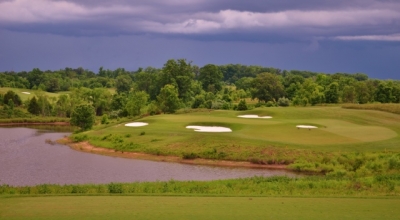 |
| If there's a 'signature' hole at Laurel Hill, it's probably the par three 16th hole. Offering two distinct teeing locations, this hole will play very differently from either one. |
Of course the variety of teeing areas will reduce the ‘size’ of the challenge for those seeking a lighter workload. Laurel Hill is wide enough to allow you to keep the ball in play, and fair enough to allow you to move along without holding anyone up with unnecessary walking strategy assessments. As you’d expect with a Bill Love design, there are plentiful natural areas (with long grasses) where you might be able to play out of, if you’re lucky enough to locate the ball.
For his part, Love would rather ‘deflect’ the credit for the success that is Laurel Hill. “We’re very happy with the way it turned out, but I would be remiss if I didn’t give a ton of credit to Rick Owens (Superintendent) and his staff, and the County guys who worked so hard to make it what it is, especially Tim Scott (the Project Manager). It makes me feel great to know the course is in such good hands.”
And if accomplishment equals clientele, then Laurel Hill’s a hit already. Orrico mentioned that there’ve been thousands of homes built just a short distance from the golf course since they signed the bill to close the prison. Figuring on demographics, that’s arguably enough to support a course on its own.
That should take care of itself. Orrico said it was a risk to build a golf course next to a prison – but Laurel Hill proves that if it’s managed effectively and the design team is right, it can be a ‘Get out of jail free’ card for your own personal use.
Notes: The name ‘Laurel Hill’ stems from the 18th century structure on property, which was the home of Revolutionary War patriot William Lindsay. This home is not open to the public.
--The USGA's U.S. Amatuer Public Links Championship will take place at Laurel Hill on July 15-20, 2013.
"It is a tremendous honor for the USGA to have selected Laurel Hill Golf Club to host this national championship," said Peter Furey, director of golf for the Fairfax County Park Authority. "This selection speaks well for the vision of the Park Authority and Fairfax County in transforming a once desolate and underutilized property into a beautiful and challenging test of golf. A championship like this draws competitors from public-access courses and speaks well of the Park Authority's mission in public golf."
Details:
Laurel Hill Golf Club
Phone: (703) 493-8849
Website: http://www.fairfaxcounty.gov/parks/golf/laurelhill/
Designer: Bill Love
General Manager: Kirk Mason
Golf Course Superintendent: Rick Owens, CGCS
Head Golf Professional: Gene Orrico, PGA
Tees/Yardage/Slope/Rating
Championship 7102 146/74.6
Black 7010 145/74.1
Blue 6730 142/72.8
White 6386 139/71.4
Gold 6021 134/69.7 143/75.1 (W)
Red 5014 124/65.2 131/69.5 (W)
Rates:
Consult the website for current rates.
Rates include cart and range balls.
Walking is allowed at any time, but there is no reduction in fees.
| Related Links | Comments on this article? | |
|
Maryland National Golf Club Hollow Creek Golf Club Rocky Gap Resort PB Dye Golf Club in Ijamsville Whiskey Creek Golf Club |
E-mail Jeff Rendall, Editor: jrendall@golftheunitedstates.com |












